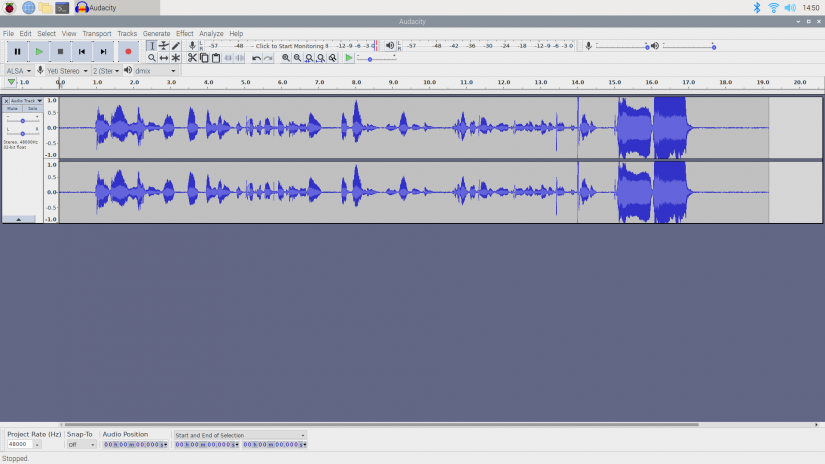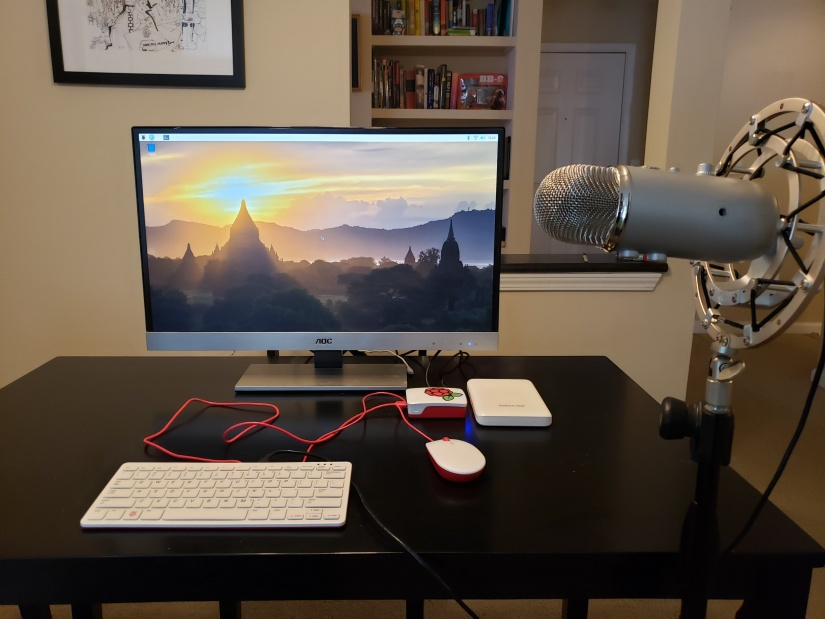
I started my writing career with a BA in English and minimal skills in the field. As a result, my first paid job was film criticism. Although I still continue to write reviews of films , the main source of income is technical media. And I managed to get into technology journalism thanks to my hobby. Being an enthusiastic design enthusiast from a young age, I constantly assembled (and sometimes broke) various devices, from restoring old desktop PCs with Linux distributions to reinstalling the OS on mobile phones. Today, however, I continue to combine my daily living with my technological and other related interests. More specifically, I host a movie podcast, and some time ago was puzzled by the search for a mobile recording studio. Despite the fact that there are many cool options , I ended up with a better idea: why not build one myself? This is how the Raspberry Pi podcasting station was born .
Why Raspberry Pi?

The Rapberry Pi is a credit card sized single board computer. Considering that RAM, CPU, GPU and all the main components are already built into this board, then for its final preparation for launch, it is enough just to write an OS image to microSD. And since there are so many Linux distributions out there for the Raspberry Pi, it's great for recording audio with programs like Audacity. With the arrival of the Raspberry Pi 4, which is available in 4GB / 8GB LPDDR4 RAM along with a great CPU, this device is perfect for basic desktop use too.... I even decided to test the Raspberry Pi 4 as my main working rig for a week, and I must say this miniature Pi has performed surprisingly well. Since recording and editing audio does not require a lot of processing power, you can do both with it.
Plus, I needed portability. I could of course lug my Razer Blade 15 around, but I still wanted something much smaller and with little power consumption. By the way, the Pi 4 is so economical in this regard that it can work from a power bank.
- Profitability . Can be powered by a power bank.
- Sufficient power . You can record and edit audio.
- Compactness . Convenient to transport.
- . .
Raspberry Pi
Very little is required to build such a studio. In general, if you are not particularly concerned about portability, then you will need the Raspberry Pi 4 itself, a miscroSD card , a keyboard , a mouse, a display with HDMI, internet access, and some free software. You probably have a lot of this on hand. Nevertheless, the goal of our project is precisely to achieve portability, in connection with which you also need a power bank and a USB monitor. In addition, you naturally need a podcast-friendly microphone , which I recommend using the Blue Yeti. As a power bank, it is best to take the device with the largest capacity (I took it at 30000mAh) with several USB ports, from which it will be possible to power the Pi and the monitor separately.
From the software, you will need a Raspberry Pi compatible Linux operating system. Raspberry Pi OS, Ubuntu, and many others are great in this regard. In addition to this, you will need to select a program for recording and editing audio, such as Audacity.
Here is a summary of the essentials:
- Raspberry Pi 4 (4GB or 8GB model recommended)
- Raspberry Pi 4 case (desirable)
- microSD card
- Podcasting microphone (Blue Yeti recommended)
- Power bank
- Portable Monitor
- Linux OS for Raspberry Pi
- Audio recording / editing software (eg Audacity)
Installing recording and editing software
First you need to understand what kind of software you need. I recommend Audacity as it is a great free, cross-platform, recordable audio editor. It works great on Windows, macOS and Linux, including ARM devices such as the Raspberry Pi.
If you are looking for a digital audio workstation (DAW), the Reaper is a worthy choice. Unfortunately it's not free, but this DRM-free DAW works great on the Raspberry Pi and other ARM-based SBCs.
If you're not keen on installing custom software, you can use Zencastr, a simple browser-based podcasting tool . To do this, you need to install Firefox on your device.
These are all three options:
Installing Audacity

After installing a Raspberry Pi compatible Linux distribution, open a terminal. In doing so, it is usually best to first update all software in use and current packages:
1 sudo apt-get update && upgradeNow you can install Audacity itself:
1 sudo apt-get install AudacityThe installation should proceed as expected, after which you can launch it from the applications menu.
Installing Reaper DAW

Even though this is a pretty serious sound workstation, the Reaper fits perfectly on Raspberry Pi and other SBCs with its ARMv7L installer. The main thing to remember is that you need to use the 32-bit version of Linux. Go to the Reaper download page and from the Linux Experimental Builds drop-down menu download the armv7l Linux installer - it will be a .tar.xz file.
Next, in the terminal, go to the directory where you downloaded the installer:
1 cd path/to/fileUnpack it (instead of file it will be your file name):
1 tar -xvf file.tar.xzIn the GUI or command line, go to the unpacked directory and run the install-reaper.sh file .
Launching Zencastr on Raspberry Pi

If Audacity and Reaper are installed locally, Zencastr works differently. In this case, instead of downloading and installing the software, you can simply run it in a browser, which is recommended to use Firefox (Chrome is also supported). So you need to start by installing your preferred bruiser on the Raspberry Pi:
1 sudo apt install firefox-esrAfter that, head to the official Zencastr website and click on Dashboard Login , then either create an account or log into an existing one.
After logging in, select Create New Episode . Come up with a name for this episode and you can move on to recording.
But first, it will not be superfluous to go to the Settings menu , where you can select an audio input device or microphone, audio output (speakers / headphones), turn on / off the sound monitor, which allows you to hear yourself in real time, activate echo cancellation, and turn on / off the built-in VoIP option.
After completing the setup, you can invite guests by going to the Invite menu, where you will need to enter their names and e-mail. When you are sure that all the necessary settings have been made, you can click Start Recording .
Connecting a microphone

After installing the software, you need to connect a microphone. If you are using the USB option, simply plug the microphone cord into the Raspberry Pi's USB port.
If you have an XLR microphone, you will need to connect it to an XLR-to-USB signal adapter or a USB-enabled mixer. Only then will you be able to connect this adapter or mixer to the Raspberry Pi via USB.
If you are interested in portability
While you can use your Raspberry Pi with a regular monitor without any problems, you can also make it portable. To do this, you will need a portable monitor as well as a large capacity power bank. The way the Pi, monitor and power bank are connected will depend on the specific configuration.
If you are using a portable monitor with HDMI input, then connect the Raspberry Pi to it using an HDMI / mini HDMI cable, and use a USB cable to power the monitor from the power bank. After that, connect the Raspberry Pi to the power bank using a USB-C to USB-A cable.
There are monitors that use the USB port not only for power, but also for A / V signal transmission. In such a case, simply connect the Raspberry Pi with a USB-C to USB-A cable to the power bank, and then connect the USB monitor cable to the Pi. Some Raspberry Pi boards may not provide enough voltage for the monitor to function, so you may need a powered USB hub.
Impressions of use
I was really pleased with this podcast recording station. It is quite comfortable, it can be easily thrown into a backpack, and all this pleasure is very inexpensive. Moreover, the decent built-in CPU and 4GB / 8GB of RAM make the Raspberry Pi quite suitable even as a desktop station for recording and editing podcasts. In turn, the low power consumption allows this device to be used as completely portable, you just need to equip it with a sufficiently capacious power-bank and a portable monitor. There is no doubt, the laptop is technically more perfect in this regard, but we are talking about a very cheap lightweight solution that just copes with the task.

